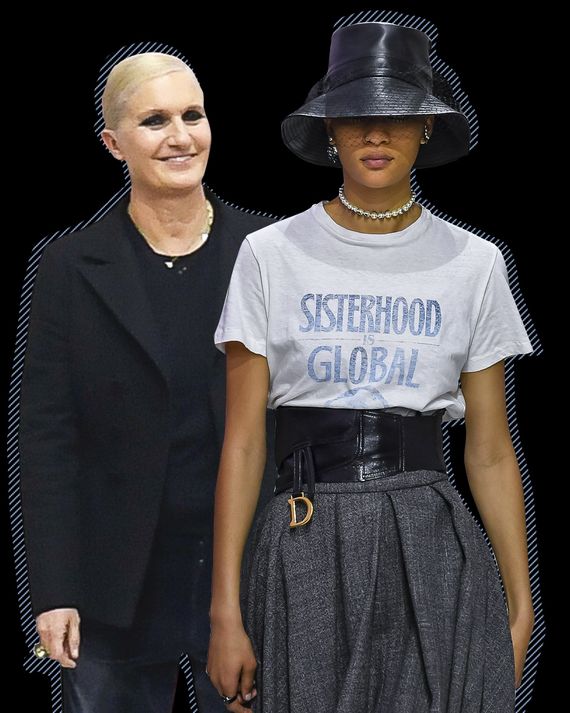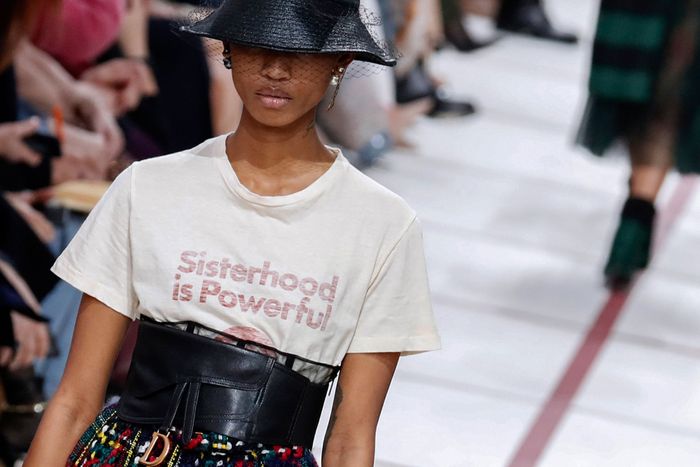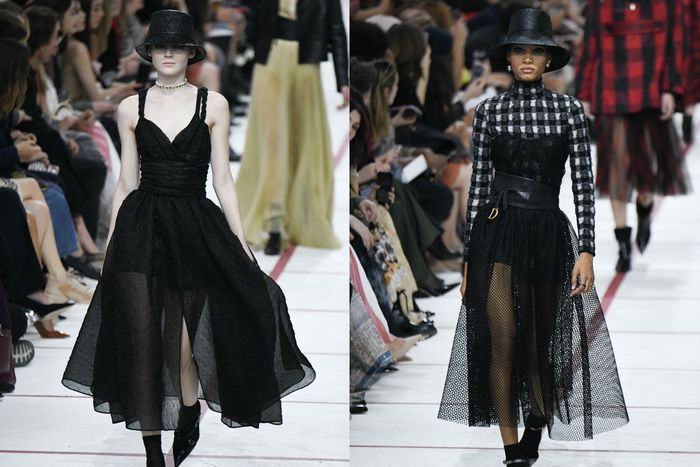
Ever since she arrived at Dior in 2016, Maria Grazia Chiuri has used the runway to make a feminist statement. It’s become sort of a thing to enter Dior’s multimillion-dollar show space — this season, on the grounds of the Musée Rodin — and see what image or artwork has been repurposed as a backdrop for the clothes and bags. One season, she showed images of student protests from the ’60s; another time, there were vintage magazine covers on the walls; couture shows have featured female acrobats.
This season it was images of a naked female body forming the letters of the alphabet, created by Tomaso Binga, an Italian artist and feminist. Binga also read a poem, in Italian, at the start of the show. And as a front row of celebrities, including Jennifer Lawrence, Bianca Jagger, and Cara Delevingne, looked on, the first model appeared in one of Chiuri’s new slogan T-shirts — “Sisterhood is Global,” taken from the title of a book of feminist essays edited by Robin Morgan.
It’s safe to assume that most in the Dior audience see Chiuri’s runway feminism exactly for what is: an attempt to look topical and also sell a T-shirt for around $750. The effort remains on the surface. For a moment yesterday, after Binga finished her solemn reading, I half hoped a model would come out wheeling a squalling baby — anything that might throw a curve into things. But Chiuri is also not a witty designer.
My beef is really with the cookie-cutter designs of the clothes. Chiuri showed 89 outfits, most based on her interpretation of the English Teddy Boy style of the 1950s, which famously included drain-pipe trousers, draped jackets, and crepe-soled shoes, and which many designers over the decades have reprised. Chiuri put her efficient spin on the hackneyed style, with some velvet drain-pipe jeans, the Dior Bar jacket nicely turned out in red tartan, a cute quilted black boiler suit, buffalo-check jackets, and many princess skirts over shorts with a heavy shoe.
Not only did Chiuri repeat herself on Tuesday; she also repeated styles from earlier seasons. Variations of the sheer princess skirt–over-shorts appeared in 2017 and 2018, for example.
Dior is a leading couture house, next to Chanel in terms of prestige and legacy. But rarely with Chiuri’s collections is there a feeling that she has put the requisite stakes on the table. A show by a major Paris house should strive to leave you with that feeling that it matters — every season. Instead of meaningless feminist slogans and a spree of merchandise, Chiuri ought to use her stage, her 15 minutes, the way Marc Jacobs did two weeks ago in New York. He made each of his 40 looks count, whether it was a luxe tuxedo or a smart-looking tweed cape with boots or a gown embroidered with black feathers. Each model looked individual, every color and fabric was carefully chosen. Because, as a creative person, it mattered to Jacobs that his audience felt something particular from the experience.
That’s a far more impactful way to present a collection in an era saturated with choices than to offer more of the same with a Teddy boy gloss. It’s also a lot a harder, creatively. You have to have ideas. You have to have something you want to impart. Those are the stakes. Given Dior’s rich history, it’s truly not too much to ask.






